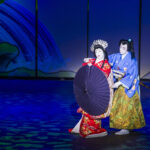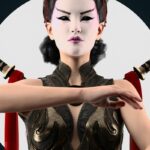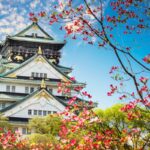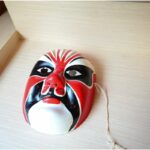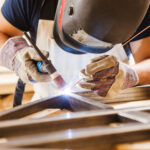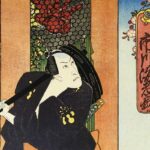Are you interested in learning about the three types of kabuki? If you are then you have come to the right place.
In this article we are going to cover the following three types of kabuki: Shosagoto, Jidaimono and Sewamono.

Each one is unique, interesting and certainly something that you need to know about if you want to see a kabuki show.
So, without further ado, let us dive right in and get started. There is loads to uncover!
Quick Answer
As the title of this article indicates, in this article we are going to cover three of the main types of kabuki plays out there.
In this section we are going to quickly cover the basics of these three types of kabuki plays so that those of you that need a quick answer can get the information that they need.
- Shosagoto – In short, this kind of kabuki play will include only dance pieces as opposed to the other types that will tell a story.
- Jidaimono – In short, this kind of kabuki play will include stories that are set in historical periods before the Edo period. For example the heian period. The characters in these kinds of play will often include lords, samurai, empresses, vassals, priests and others of a similar nature and fit in the setting.
- Sewamono – In short, this kind of kabuki play will include stories that were written by Chikamastu Monzaemon. These plays will consist of stories about characters like merchants, prostitutes, shopkeepers, firemen and other common people. This variety of kabuki play will normally focus on the life of the common people and some conflict that occurs.
Now that you have a basic understanding of these three types of kabuki plays, you should certainly read on. There is a lot that we do not mention in this section. So, make sure to read on to learn more about these types of kabuki plays.
The Three Types Of Kabuki Plays
Kabuki Can be divided up into three different types of play, Shosagoto, Jidaimono and Sewamono.
The basis of each of these plays is dance which means that each and every actor must go through strict and intensive training.
But what do these three types of kabuki actually mean or entail? Well, below we have written a brief section on each of these types so that you can better understand them.
So, without further ado, let us dive right in and get started!
Shosagoto
This variety of kabuki play is going to almost entirely revolve around dance pieces.
These beautiful performances often consist of Mai. This is essentially a circling movement in which the heels of the dancer are kept very close to the floor.
These kabuki dancers will use many different fans. One of the most common ones is the Japanese fan.
As a result of women being banned from kabuki many years ago, this dance is not performed by the Onnagata actors or Binnie.
Jidaimono
This kind of kabuki play will usually be set in an old historical period. For example the heian period.
The characters that you see in these plays will usually be lords, samurai, empresses, vassals, priests and others of a similar nature and fit in the setting.
The stories told in jidaimono kabuki plays will usually be set in time periods before the Edo period. This theme will impact the characters props, storytelling and just about everything you see on set.
The kabuki actors in these plays will change their names slightly from the historical figures that they are playing in the kabuki act.
Sewamono
The sewamono kabuki plays are written by someone named Chikamastu Monzaemon.
The characters within these plays will normally include characters such as merchants, prostitutes, shopkeepers, firemen and other common people.
This variety of kabuki play will normally focus on the life of the common people and some conflict that occurs.
For example how a character might have conflict between the duty they have to their family and the duty they have to themselves as people. This may include something as simple as a forbidden love between families or something like that.
A Bit About Kabuki
In this section we are going to take a closer look at kabuki and factors that impact a performance. So, without further ado, let us dive right in and get started!
The Kabuki Performance
The actors at a kabuki performance are as much actors as they are dancers.
They must dance while also portraying a character and remain perfectly. During the performance you will notice that a kabuki actor will move in a very stylized way.
This movement will usually be accompanied by the sound of wooden clappers, drums and traditional flutes.
The speaking that occurs in a performance is spoken by the actors or a narrator which is known as the ‘Gidahu’. There is a great deal of detail and work that goes into a performance.
Actors aside everything will look different depending on the setting, time of year and many other factors. The detail can be as miniscule as how an actor acts when they are holding a hot drink or a cold drink like sake (to learn more about drinking sake, read here).
The type of cup, and what is being drunk will play a huge role in the performance that the actor gives.
At the end of the day, there is a great deal that goes into getting the perfect performance. From the actor doing the smallest gesture to the makeup, set, costuming and everything else.
Everything is portrayed specifically to make it fall into what kabuki is at its core.
The Theater Facilities
A theater house for kabuki will normally include a large hall with a stage and places for the audience (see also ‘All About Hanamichi: Kabuki Stage Design‘). The stage will be separated from the audience by way of a curtain which will be drawn to the sides.
Normally there will be a runway which is linked to the back of a stage. This runway will pass through the audience. It is also known as the flower way or hanamichi.
The hanamichi gets its name because it was made originally as a way for the audience to present flowers to the kabuki actors.
When eventually the 1730s rolled around this famous runway had become a supplementary staging area.
The Makeup Used In Kabuki
Regardless of what type of kabuki you are watching, the actors are more than likely to be wearing some kind of thick makeup. The designs are all designed to help represent and portray a specific character.
For example, if a character has a red stripe around the cheek and eyes it is a symbol of power and youth. If a character has a dark indigo blue on their face it is likely a symbol of negative attributes in that character.
Final Thoughts
We hope that you have enjoyed this article and learning about these fascinating types of kabuki. There is plenty more to learn about this traditional Japanese art form. Luckily for you, we cover a bunch of Japan related topics.
It will almost certainly be worth your while to check out some of our other articles. There is almost certainly bound to be something that you will enjoy.
With all of that said, have fun learning about Japan and its culture.
- 16 Best Websites To Watch Japanese Movies With English Subtitles - May 11, 2023
- Is ZIPAIR The Best Airline For Traveling To Japan? - May 11, 2023
- Ryu Murakami Vs Haruki Murakami – Which One Should You Read? - May 11, 2023

